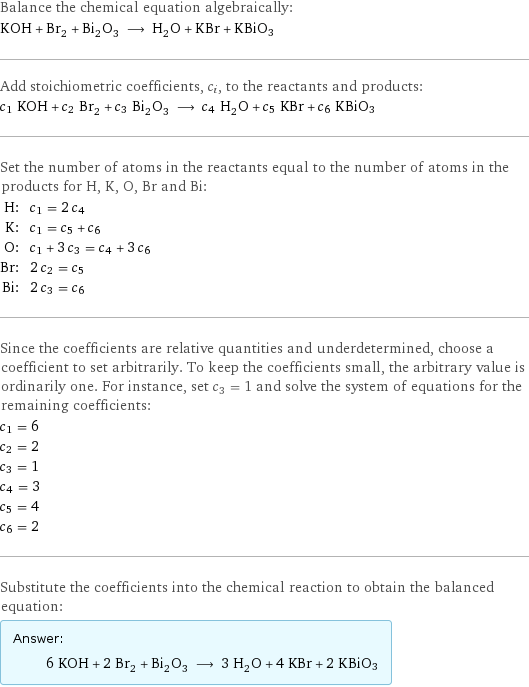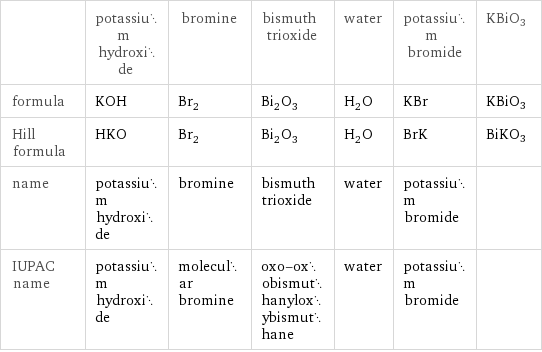Input interpretation

KOH (potassium hydroxide) + Br_2 (bromine) + Bi_2O_3 (bismuth trioxide) ⟶ H_2O (water) + KBr (potassium bromide) + KBiO3
Balanced equation

Balance the chemical equation algebraically: KOH + Br_2 + Bi_2O_3 ⟶ H_2O + KBr + KBiO3 Add stoichiometric coefficients, c_i, to the reactants and products: c_1 KOH + c_2 Br_2 + c_3 Bi_2O_3 ⟶ c_4 H_2O + c_5 KBr + c_6 KBiO3 Set the number of atoms in the reactants equal to the number of atoms in the products for H, K, O, Br and Bi: H: | c_1 = 2 c_4 K: | c_1 = c_5 + c_6 O: | c_1 + 3 c_3 = c_4 + 3 c_6 Br: | 2 c_2 = c_5 Bi: | 2 c_3 = c_6 Since the coefficients are relative quantities and underdetermined, choose a coefficient to set arbitrarily. To keep the coefficients small, the arbitrary value is ordinarily one. For instance, set c_3 = 1 and solve the system of equations for the remaining coefficients: c_1 = 6 c_2 = 2 c_3 = 1 c_4 = 3 c_5 = 4 c_6 = 2 Substitute the coefficients into the chemical reaction to obtain the balanced equation: Answer: | | 6 KOH + 2 Br_2 + Bi_2O_3 ⟶ 3 H_2O + 4 KBr + 2 KBiO3
Structures

+ + ⟶ + + KBiO3
Names

potassium hydroxide + bromine + bismuth trioxide ⟶ water + potassium bromide + KBiO3
Equilibrium constant
![Construct the equilibrium constant, K, expression for: KOH + Br_2 + Bi_2O_3 ⟶ H_2O + KBr + KBiO3 Plan: • Balance the chemical equation. • Determine the stoichiometric numbers. • Assemble the activity expression for each chemical species. • Use the activity expressions to build the equilibrium constant expression. Write the balanced chemical equation: 6 KOH + 2 Br_2 + Bi_2O_3 ⟶ 3 H_2O + 4 KBr + 2 KBiO3 Assign stoichiometric numbers, ν_i, using the stoichiometric coefficients, c_i, from the balanced chemical equation in the following manner: ν_i = -c_i for reactants and ν_i = c_i for products: chemical species | c_i | ν_i KOH | 6 | -6 Br_2 | 2 | -2 Bi_2O_3 | 1 | -1 H_2O | 3 | 3 KBr | 4 | 4 KBiO3 | 2 | 2 Assemble the activity expressions accounting for the state of matter and ν_i: chemical species | c_i | ν_i | activity expression KOH | 6 | -6 | ([KOH])^(-6) Br_2 | 2 | -2 | ([Br2])^(-2) Bi_2O_3 | 1 | -1 | ([Bi2O3])^(-1) H_2O | 3 | 3 | ([H2O])^3 KBr | 4 | 4 | ([KBr])^4 KBiO3 | 2 | 2 | ([KBiO3])^2 The equilibrium constant symbol in the concentration basis is: K_c Mulitply the activity expressions to arrive at the K_c expression: Answer: | | K_c = ([KOH])^(-6) ([Br2])^(-2) ([Bi2O3])^(-1) ([H2O])^3 ([KBr])^4 ([KBiO3])^2 = (([H2O])^3 ([KBr])^4 ([KBiO3])^2)/(([KOH])^6 ([Br2])^2 [Bi2O3])](../image_source/656dd1ffd7464ba15e8f949244e881d9.png)
Construct the equilibrium constant, K, expression for: KOH + Br_2 + Bi_2O_3 ⟶ H_2O + KBr + KBiO3 Plan: • Balance the chemical equation. • Determine the stoichiometric numbers. • Assemble the activity expression for each chemical species. • Use the activity expressions to build the equilibrium constant expression. Write the balanced chemical equation: 6 KOH + 2 Br_2 + Bi_2O_3 ⟶ 3 H_2O + 4 KBr + 2 KBiO3 Assign stoichiometric numbers, ν_i, using the stoichiometric coefficients, c_i, from the balanced chemical equation in the following manner: ν_i = -c_i for reactants and ν_i = c_i for products: chemical species | c_i | ν_i KOH | 6 | -6 Br_2 | 2 | -2 Bi_2O_3 | 1 | -1 H_2O | 3 | 3 KBr | 4 | 4 KBiO3 | 2 | 2 Assemble the activity expressions accounting for the state of matter and ν_i: chemical species | c_i | ν_i | activity expression KOH | 6 | -6 | ([KOH])^(-6) Br_2 | 2 | -2 | ([Br2])^(-2) Bi_2O_3 | 1 | -1 | ([Bi2O3])^(-1) H_2O | 3 | 3 | ([H2O])^3 KBr | 4 | 4 | ([KBr])^4 KBiO3 | 2 | 2 | ([KBiO3])^2 The equilibrium constant symbol in the concentration basis is: K_c Mulitply the activity expressions to arrive at the K_c expression: Answer: | | K_c = ([KOH])^(-6) ([Br2])^(-2) ([Bi2O3])^(-1) ([H2O])^3 ([KBr])^4 ([KBiO3])^2 = (([H2O])^3 ([KBr])^4 ([KBiO3])^2)/(([KOH])^6 ([Br2])^2 [Bi2O3])
Rate of reaction
![Construct the rate of reaction expression for: KOH + Br_2 + Bi_2O_3 ⟶ H_2O + KBr + KBiO3 Plan: • Balance the chemical equation. • Determine the stoichiometric numbers. • Assemble the rate term for each chemical species. • Write the rate of reaction expression. Write the balanced chemical equation: 6 KOH + 2 Br_2 + Bi_2O_3 ⟶ 3 H_2O + 4 KBr + 2 KBiO3 Assign stoichiometric numbers, ν_i, using the stoichiometric coefficients, c_i, from the balanced chemical equation in the following manner: ν_i = -c_i for reactants and ν_i = c_i for products: chemical species | c_i | ν_i KOH | 6 | -6 Br_2 | 2 | -2 Bi_2O_3 | 1 | -1 H_2O | 3 | 3 KBr | 4 | 4 KBiO3 | 2 | 2 The rate term for each chemical species, B_i, is 1/ν_i(Δ[B_i])/(Δt) where [B_i] is the amount concentration and t is time: chemical species | c_i | ν_i | rate term KOH | 6 | -6 | -1/6 (Δ[KOH])/(Δt) Br_2 | 2 | -2 | -1/2 (Δ[Br2])/(Δt) Bi_2O_3 | 1 | -1 | -(Δ[Bi2O3])/(Δt) H_2O | 3 | 3 | 1/3 (Δ[H2O])/(Δt) KBr | 4 | 4 | 1/4 (Δ[KBr])/(Δt) KBiO3 | 2 | 2 | 1/2 (Δ[KBiO3])/(Δt) (for infinitesimal rate of change, replace Δ with d) Set the rate terms equal to each other to arrive at the rate expression: Answer: | | rate = -1/6 (Δ[KOH])/(Δt) = -1/2 (Δ[Br2])/(Δt) = -(Δ[Bi2O3])/(Δt) = 1/3 (Δ[H2O])/(Δt) = 1/4 (Δ[KBr])/(Δt) = 1/2 (Δ[KBiO3])/(Δt) (assuming constant volume and no accumulation of intermediates or side products)](../image_source/810bbfe35154a8058f5bcf8e53ae5288.png)
Construct the rate of reaction expression for: KOH + Br_2 + Bi_2O_3 ⟶ H_2O + KBr + KBiO3 Plan: • Balance the chemical equation. • Determine the stoichiometric numbers. • Assemble the rate term for each chemical species. • Write the rate of reaction expression. Write the balanced chemical equation: 6 KOH + 2 Br_2 + Bi_2O_3 ⟶ 3 H_2O + 4 KBr + 2 KBiO3 Assign stoichiometric numbers, ν_i, using the stoichiometric coefficients, c_i, from the balanced chemical equation in the following manner: ν_i = -c_i for reactants and ν_i = c_i for products: chemical species | c_i | ν_i KOH | 6 | -6 Br_2 | 2 | -2 Bi_2O_3 | 1 | -1 H_2O | 3 | 3 KBr | 4 | 4 KBiO3 | 2 | 2 The rate term for each chemical species, B_i, is 1/ν_i(Δ[B_i])/(Δt) where [B_i] is the amount concentration and t is time: chemical species | c_i | ν_i | rate term KOH | 6 | -6 | -1/6 (Δ[KOH])/(Δt) Br_2 | 2 | -2 | -1/2 (Δ[Br2])/(Δt) Bi_2O_3 | 1 | -1 | -(Δ[Bi2O3])/(Δt) H_2O | 3 | 3 | 1/3 (Δ[H2O])/(Δt) KBr | 4 | 4 | 1/4 (Δ[KBr])/(Δt) KBiO3 | 2 | 2 | 1/2 (Δ[KBiO3])/(Δt) (for infinitesimal rate of change, replace Δ with d) Set the rate terms equal to each other to arrive at the rate expression: Answer: | | rate = -1/6 (Δ[KOH])/(Δt) = -1/2 (Δ[Br2])/(Δt) = -(Δ[Bi2O3])/(Δt) = 1/3 (Δ[H2O])/(Δt) = 1/4 (Δ[KBr])/(Δt) = 1/2 (Δ[KBiO3])/(Δt) (assuming constant volume and no accumulation of intermediates or side products)
Chemical names and formulas

| potassium hydroxide | bromine | bismuth trioxide | water | potassium bromide | KBiO3 formula | KOH | Br_2 | Bi_2O_3 | H_2O | KBr | KBiO3 Hill formula | HKO | Br_2 | Bi_2O_3 | H_2O | BrK | BiKO3 name | potassium hydroxide | bromine | bismuth trioxide | water | potassium bromide | IUPAC name | potassium hydroxide | molecular bromine | oxo-oxobismuthanyloxybismuthane | water | potassium bromide |